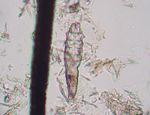Demodex
Revision as of 22:51, 30 March 2010 by Bara (talk | contribs) (Created page with 'right|thumb|150px|''Demodex canis'' - Wikimedia Commons *''Demodex spp.'' found on all domestic mammals and in humans **Each host has its own species …')
- Demodex spp. found on all domestic mammals and in humans
- Each host has its own species
- Causes demodecosis
Recognition
- Cigar shaped
- Four pairs of stumpy legs on the anterior end
- Long and narrow to fit into hair follicles
Life cycle
- Live as commensal organisms
- Live in hair follicles and in sebaceous glands
- Life cycle takes 3 weeks
Pathogenesis and epidemiology
Dogs
- Initial infection is slight hair loss which may resolve spontaneously or could spread over the body
- Squamous demodecosis
- Less serious
- Dry reaction
- Alopecia, desquamation and skin thickening
- Absent to mild pruritus
- Follicular/pustular demodecosis
- More serious
- Skin invasion by staphylococci
- Skin becomes wrinkled, thickened and contains pustules which ooze serum, blood or pus
- Affected animals may be seriously disfigured
- Severe pruritus is associated with secondary infection
- Immune factors are important in determining the severity and occurrence of demodecosis
- Familial susceptibility
- Immunosuppression
- Immunosuppressant therapy
Cats
- Rare
- Confined to the periocular region
- Mild squamous type only
Cattle
- Pea-sized nodules in the skin
- Each nodule contains several thousand mites
- Affects hide quality
- Economically important in Australia
Goats
- Becoming more common in goats
- Disease similar to that in cattle
Pigs, Sheep and Horses
- Rare
Diagnosis
- Liquid paraffin applied to a skin fold
- Deep skin scraping
Control
- Not easily accessible to acaricides due to their deep location in the skin
- Repeat treatments needed
- Recovery may take several months
- To aid acaricide penetration, clipping a dog's coat and washing is recommended
